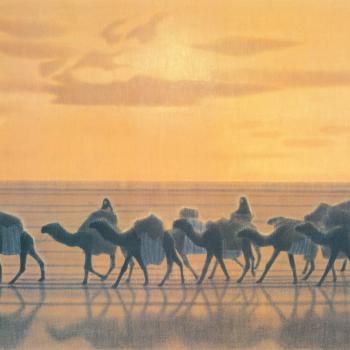The literature that survives from medieval Central Asia generally evolved from oral tradition, and includes much poetry as well as prose literature. From Iran there survives a bi-lingual literary heritage, in both Arabic and Persian, and the earliest examples of a growing literary culture across Central Asia can be found in the inscriptions of the Turkic, Tibetan, and Mongolian peoples.
Music was important in Central Asia in the antique and medieval periods, and is often referenced in sources, but there is no extant musical notation from this time. It was a feature of Buddhism, and we know that Buddhist orchestras existed, and remained integral to Central Asian society after the spread of Islam. Music played a part in many aspects of daily life; from the academic study of music to the visits of performing artists and its role in local cultural events, such as festivals, story-telling, dances, and theatre.
There is a variety of extant literature from Sasanian Iran, reflecting the culture, traditions and legends of the empire and its people. The secular literature consists of the chronicles of Sasanian kings, as well as epic histories and scientific treatises. Philosophy, theological works, wisdom literature (Andarz), and visionary texts feature among the religious literature from this era.
There remains much to be discovered about the languages and literature of the Kushan Empire, to the extent that a new language in an unknown script has been discovered recently. Sanskrit and Prakrit are both literary languages that pre-date the Kushan Empire, whilst Bactrian developed to become a ‘literary’ language in this era. Sogdian is also important, spoken by the merchants who were engaged in the silk trade and who thus traversed Central Asia.
The vast Kushan Empire (from the first to the fourth centuries AD) held a number of divergent artistic cultures within its borders. These can be divided into four broad regions: Bactria (in the basin of the Oxus), Arachosia and Nagarahara (now in modern Afghanistan and Pakistan), ancient Gandhara (also now situated in modern Pakistan and Afghanistan), and Mathura in India. Yet despite their differences, these artistic cultures were politically united under a single state.
The International Institute for Central Asian Studies (IICAS) was established in August 1995 in Samarkand (Uzbekistan) as a direct outcome of the UNESCO Silk Roads Expeditions. The idea of founding the Institute was conceived during the Steppe Route Expedition across Central Asia, one of the expeditions organized within the framework of UNESCO Project "Integral Study of the Silk Roads: Roads of Dialogue", a major project of the World Decade for Cultural Development (1987-1997).
SOAS, the School of Oriental and African Studies (University of London) is dedicated to the study of the languages, cultures and societies of Africa, Asia and the Middle East, and is the only Higher Education institution in Europe with this academic specialisation. It also has the largest concentration in Europe of academic staff concerned with Africa, Asia and the Middle East.





